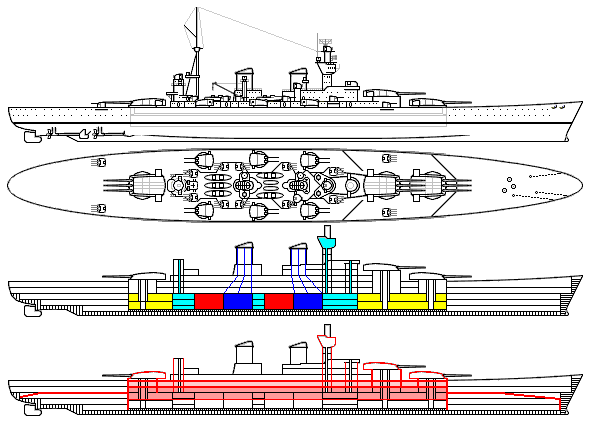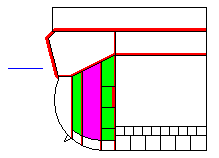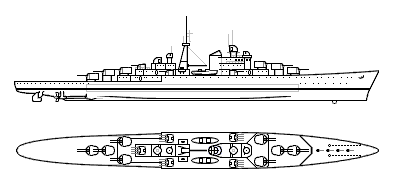
The largest ship of the year.
Two vessels to be laid down as replacements for
Conte di Cavour and
Andrea Doria. Provisional names are
Littorio and
Vittorio Veneto.
The design builds on the cancelled VEIII class from 1928. The overall layout is similar but there are subtle design differences.
Hull: Slightly beamier for a wider TDS. No quarterdeck aft and generally higher freeboard to give better seakeeping.
Machinery: Same with 160,000shp on 4 shafts. Improvements to the hull form have allowed the maximum speed to be increased to around 31knts. Less bunkerage as the range of the previous ship was thought to be excessive. Triple rudders used instead of the old single rudder.
Superstructure: Generally larger. Moves away from the previous tower superstructure. Fitted with newer San Giorgio AA directors and a larger main rangefinder. (Electronics fit pictured as fitted 1937 with EC.2 and Lince)
Main Armament: Similar main armament with 9x381/50 guns in 3 triple turrets fore and aft.
Secondary Armament: New Dual-Purpose 152mm/53 guns fitted in twin mountings on the beam. They are thought to be generally superior for AA and ASuW use to the 135/45 triples.
AA armament: Increased since 1928 with newer 47mm guns and more of them. Will probably be fitted with some 20mm FFL guns in service in unpowered mountings.
Belt Armour: Main belt is thinner but improvements in quality mean that it's effectiveness is about the same. 70mm external decapping plate with 280mm outer hull plate inclined at 15°. Upper belt removed for weight saving. A lower belt in the TDS is used to stop diving shells. It is of 150mm thickness and 1m deep.
Deck Armour: Quite a change with no burster deck used. Instead there is a thick armoured deck level with the top of the armour belt. It is 175mm thick over the magazines and 155mm thick over the machinery. Below is a 25mm thick splinter deck with slopes on the outside leading to the bottom of the belt armour. The steering gear has a 100mm thick armoured box.
Other armour: The main turrets have 350mm faces, 200mm roofs and 350mm rears. They are mounted on 350mm thick barbettes. Conning tower armour is just 70mm splinter plate so as not to detonate large calibre rounds.
Other notes: Quarterdeck is strengthened allowing for vertiplane landings.

Red: Armour Blue: Legend Waterline Green: Liquid loaded portions of TDS Pink: Pugliese filling (half cylinders)
Battleship laid down 1934
Displacement:
39,841 t light; 41,940 t standard; 46,053 t normal; 49,344 t full load
Dimensions: Length overall / water x beam x draught
813.85 ft / 787.40 ft x 104.99 ft (Bulges 108.27 ft) x 33.46 ft (normal load)
248.06 m / 240.00 m x 32.00 m (Bulges 33.00 m) x 10.20 m
Armament:
9 - 15.00" / 381 mm guns (3x3 guns), 1,951.09lbs / 885.00kg shells, 1934 Model
Breech loading guns in turrets (on barbettes)
on centreline ends, majority forward, 1 raised mount - superfiring
12 - 5.98" / 152 mm guns (6x2 guns), 99.21lbs / 45.00kg shells, 1934 Model
Dual purpose guns in turrets (on barbettes)
on side, all amidships
56 - 1.85" / 47.0 mm guns (14x4 guns), 3.86lbs / 1.75kg shells, 1934 Model
Anti-aircraft guns in deck mounts
on side, evenly spread
Weight of broadside 18,966 lbs / 8,603 kg
Shells per gun, main battery: 110
Armour:
- Belts: Width (max) Length (avg) Height (avg)
Main: 13.8" / 350 mm 436.35 ft / 133.00 m 13.12 ft / 4.00 m
Ends: Unarmoured
Main Belt covers 85 % of normal length
- Torpedo Bulkhead and Bulges:
2.17" / 55 mm 436.35 ft / 133.00 m 32.81 ft / 10.00 m
- Gun armour: Face (max) Other gunhouse (avg) Barbette/hoist (max)
Main: 13.8" / 350 mm 9.06" / 230 mm 13.8" / 350 mm
3rd: 5.31" / 135 mm 2.76" / 70 mm 2.76" / 70 mm
4th: 0.39" / 10 mm 0.39" / 10 mm -
- Armour deck: 6.18" / 157 mm, Conning tower: 2.76" / 70 mm
Machinery:
Oil fired boilers, steam turbines,
Geared drive, 4 shafts, 160,000 shp / 119,360 Kw = 31.14 kts
Range 4,200nm at 25.00 kts
Bunker at max displacement = 7,403 tons
Complement:
1,571 - 2,043
Cost:
£18.592 million / $74.366 million
Distribution of weights at normal displacement:
Armament: 2,081 tons, 4.5 %
Armour: 15,117 tons, 32.8 %
- Belts: 3,500 tons, 7.6 %
- Torpedo bulkhead: 1,147 tons, 2.5 %
- Armament: 3,426 tons, 7.4 %
- Armour Deck: 6,968 tons, 15.1 %
- Conning Tower: 76 tons, 0.2 %
Machinery: 4,603 tons, 10.0 %
Hull, fittings & equipment: 17,440 tons, 37.9 %
Fuel, ammunition & stores: 6,212 tons, 13.5 %
Miscellaneous weights: 600 tons, 1.3 %
Overall survivability and seakeeping ability:
Survivability (Non-critical penetrating hits needed to sink ship):
65,431 lbs / 29,679 Kg = 38.8 x 15.0 " / 381 mm shells or 10.0 torpedoes
Stability (Unstable if below 1.00): 1.16
Metacentric height 7.1 ft / 2.2 m
Roll period: 17.1 seconds
Steadiness - As gun platform (Average = 50 %): 50 %
- Recoil effect (Restricted arc if above 1.00): 0.53
Seaboat quality (Average = 1.00): 1.02
Hull form characteristics:
Hull has a flush deck
and transom stern
Block coefficient: 0.565
Length to Beam Ratio: 7.27 : 1
'Natural speed' for length: 32.62 kts
Power going to wave formation at top speed: 54 %
Trim (Max stability = 0, Max steadiness = 100): 49
Bow angle (Positive = bow angles forward): 30.00 degrees
Stern overhang: 6.56 ft / 2.00 m
Freeboard (% = measuring location as a percentage of overall length):
- Stem: 34.45 ft / 10.50 m
- Forecastle (20 %): 22.97 ft / 7.00 m
- Mid (50 %): 21.33 ft / 6.50 m
- Quarterdeck (15 %): 21.33 ft / 6.50 m
- Stern: 21.33 ft / 6.50 m
- Average freeboard: 22.82 ft / 6.96 m
Ship space, strength and comments:
Space - Hull below water (magazines/engines, low = better): 85.1 %
- Above water (accommodation/working, high = better): 160.3 %
Waterplane Area: 60,934 Square feet or 5,661 Square metres
Displacement factor (Displacement / loading): 111 %
Structure weight / hull surface area: 206 lbs/sq ft or 1,005 Kg/sq metre
Hull strength (Relative):
- Cross-sectional: 0.97
- Longitudinal: 1.33
- Overall: 1.00
Hull space for machinery, storage, compartmentation is adequate
Room for accommodation and workspaces is excellent
Deck
40mm Forwards, 155+25 machinery, 175+25 magazines, 100mm aft
Belt
70+350@15
Lower belt 150mm x 1m deep 310tons


Quoted
Originally posted by Red Admiral


Quoted
Originally posted by Hrolf Hakonson